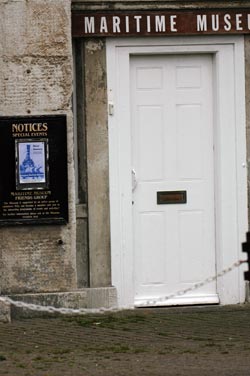Sigma 300-800mm f/5.6 EX DG HSM
This lens from Sigma is in a class of it’s own! Nobody else makes anything like it! Nothing else (apart from it’s prime brother) that you can buy off the shelf for less than the price of a house has this sort of reach. So why have Sigma gone to such extremes? We take a look.
 Specification
Specification
- Focal length 300-800mm
- Max aperture f/5.6
- Min aperture f/32
- Min focus distance 6m
- Filter size 46mm drop in
- Dimensions 156.5x544mmWeight 5.88kg
- Mount Sigma, Canon, Nikon
- Price £4999.00p
Build and Handling
This lens has been affectionately nicknamed the ‘Sigmonster’ due to its rather large size along with it’s huge focal range. Despite the range, the lens is still only a 2.7x zoom due to the range starting where most zoom lenses would be tailing off and calling it a day! The lens itself is built like the proverbial ‘brick outhouse’ and comes supplied with a massive tripod bush and metal lens hood all contained in a purpose made semi-soft case. The case is the worst thing about it and badly needs re-designing. Twin zips, which are far too lightweight for the job, open the front of the case to allow access to the lens that is cosseted inside it. Don’t get me wrong, the lens is well protected, but the whole box shaped case is a nightmare to carry!
A strong, single strap is provided, which is fine until you put it on your shoulder. Due to the shape and weight, it just won’t stay there! Twin straps, so that the lens can be carried on your back, would be much more usable and I found it far easier to mount the lens on a tripod and use the tripod as a carry handle over your shoulder, so the case stayed in the boot of the car!
As stated, the lens is well built. The AF/MF switch is in the usual place and forward of that is a drop-in filter slot with a pair of lugs that need to be pinched to remove the filter. Immediately in front of it is a ring for turning filters once in place and next is a collar with a substantial strap mount for a carrying strap. Some 70mm up the lens, passing the nameplate on the way, is the zoom control ring. Despite being big enough to get your whole fist around it, it is nicely torqued and smooth in operation. About a third of a turn, clockwise as you hold the camera, takes you from 300mm through to the 800mm mark.
Next up is a distance window marked in metres and feet although there is no attempt at a DOF scale. The manual focus ring steps up in diameter next and is again big enough for virtually your whole hand but is finger light in use. Just under half a turn takes you through the whole focus range. The ring does not turn during autofocus although full time manual over-ride is available should you need it. The HSM focus system is responsive and silent in use and I found it snapped into place quickly. Another step up in diameter follows before you reach the massive tripod collar. A knob on the left side frees the collar to rotate, or, more correctly, for the lens to rotate in it. The shoe doubles up as a carry handle with the end sporting the second strap mount.
Forward of the collar, the lens takes a couple more hikes in diameter before reaching the massive front element. The large metal hood mounts around this with a bayonet fit supported by a screw-in knob to fix it in place or reverse it for storage in that case with a supplied ‘bucket’ type lens cap held on with velcro.
There is no way that anyone is going to hand hold this lens but it does balance well on the tripod mount and performed well when propped on a beanbag on the sill of a hide window. When on the beanbag, the constant length and lack of moving parts during focussing make it easy to use. A nice touch would be a focus limiter, but that is just being greedy! With a lens of this size and focal length, get the support right and you are well over half way to achieving sharp pictures. Once supported, it is not going to move far whatever camera is mounted on the back of it!
Optical quality
The optical qualities of the lens make it worth carrying the weight along with you. It is sharp throughout the range, has excellent contrast and good neutral colour rendition. With a constant aperture of f/5.6 throughout the focal lengths and excellent performance wide open there is very little to criticise. Distortion is almost immeasurable with figures of less than a half of one percent at both ends of the zoom. Chromatic aberrations are also non existent until refraction kicks in at smaller apertures and even then they are well controlled. The only nit-pick I could come up with, and that is not really a quality problem is the close focus distance of six metres. That is a long way off!
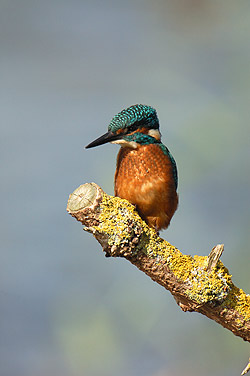 | 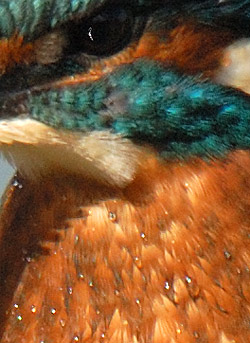 ePHOTOzines famous kingfisher shot at 1/1000sec and f/8 on a D70 with the lens set at 800mm. ISO400. A 100% crop shows the detail the lens is capable of. Remember that this bird has a body size similar to that of a house sparrow! |
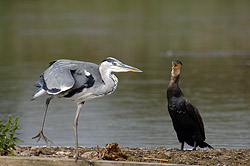 1/640sec at f/8 and 800mm. ISO400 on a D2X. The ability to capture behaviour that would otherwise be disturbed is one of the advantages of this lens. | 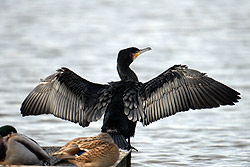 Another behaviour trait that would be disturbed with the photographer being closer. This one shot on a D2X set at 1/8000sec and f/8. ISO 320 and 700mm |
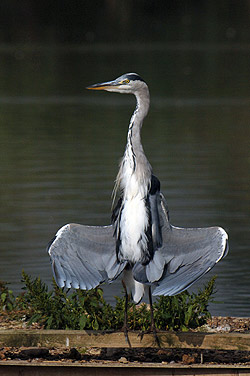 | Cormorant stretching its wings out to dry. The lens is a very specialised piece of kit, but comes into its own in this type of situation. D200 at 1/640sec and f/7.1. ISO 500 and 800mm
|
Click on each comparision photo below to view full size versions
Below is our lens test data. To find out how to use these graphs look at this article: How we test lenses
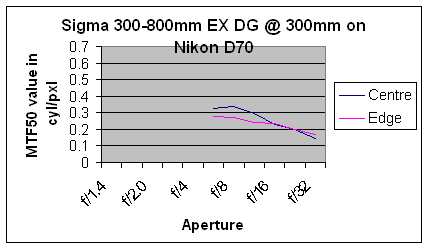
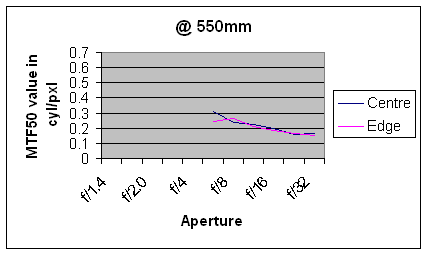
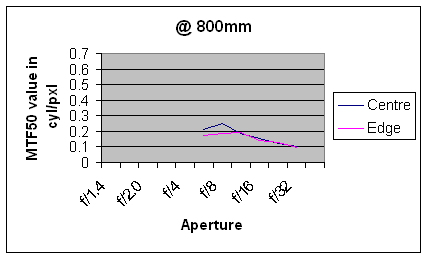
Verdict
This is a specialist lens, which only comes into its own in the fields of sports and wildlife photography and possibly some aviation uses. However, once it is in a situation where it is comfortable, there is not a lot that can touch it. With converters, it can match the focal lengths achieved by Digiscoping with an enormous leap in quality. Yes, it is a big, heavy lump and the absolute minimum is a sturdy monopod or tripod to support it and, if you have one, a Sherpa to carry it for you. Failing that, mount it on the tripod, put the beanbag on your shoulder and it balances quite well. The case protects it but proved useless for carrying it! I’ve used it on 4,6,10 and 12mp cameras and all the results are stunning.
In summary, the positive points of the Sigma 300-800mm f/5.6 EX DG HSM are:
![]() Excellent picture quality
Excellent picture quality
![]() Astonishing focal range.
Astonishing focal range.
![]() Fast and silent autofocus.
Fast and silent autofocus.
![]() Good price for the capabilities.
Good price for the capabilities.
The negative points are:
![]() Big and heavy.
Big and heavy.
![]() Could benefit from a focus limiter
Could benefit from a focus limiter
![]() Closest focus at 6m is a bit far
Closest focus at 6m is a bit far
![]() Case leaves a lot to be desired.
Case leaves a lot to be desired.
Check the latest price of the Sigma 300-800mm EX DG HSM here
Test by Ian Andrews
Add your message
Please login here or if you've not registered, you can register here. Registering is safe, quick and free.
photodo Stats
428 MTF tests
74 in-depth photodo reviews
100+ users join each day
Help the lens community by reviewing or rating a lens today via our lens search
Latest Lens Reviews
- Chinon 28mm f/2.8 Vintage Lens Review
- Canon EF 70-200mm f/4L IS II USM Lens Review
- Samyang AF 85mm f/1.4 EF Review
- Sigma 70mm f/2.8 DG Macro Art Review
- Samyang AF 24mm f/2.8 FE Review
- Meike 50mm f/1.7 Review
- Tamron 70-210mm f/4 Di VC USD Review
- Lensbaby Burnside 35mm f/2.8 Review
- Asahi Super Takumar 50mm f/1.4 Review
- Asahi Super-Multi-Coated Takumar 135mm f/3.5 Review


